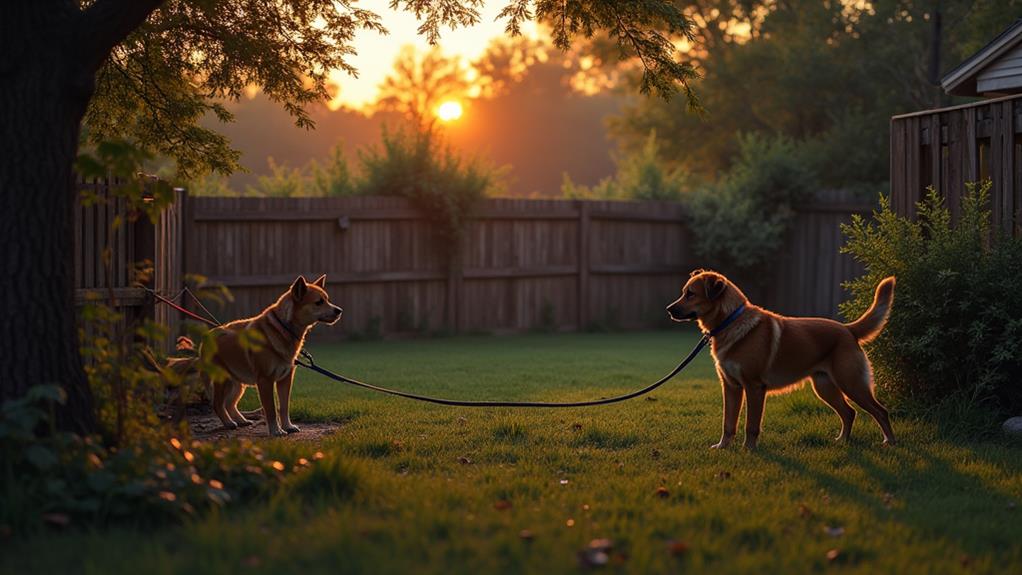Wild red foxes aren't dangerous to you, so there's no need to panic if you spot one in your yard! They're usually curious rather than aggressive, and attacks on humans are super rare. While they may eye your small pets like kittens or little dogs—so keep an eye on them—most times, foxes just want to go about their business. If you encounter a fox, stay calm, give it space, and avoid feeding it. Understanding their behavior can help you coexist peacefully with these clever creatures, and there's even more to learn about how to stay safe around them!
Contents
Overview of Wild Red Foxes

When you think of wild red foxes, picture a clever creature gracefully maneuvering its habitat. These fascinating animals belong to the Canidae family and are known for their sleek appearance and playful nature.
They usually weigh between 8 to 24 pounds and can stretch from 1 to 3 feet long, their bushy tails a striking feature often tipped in white or black. The red fox (Vulpes vulpes) is the largest true fox species, found in diverse habitats across North America, Europe, Asia, and northern Africa, often adapting to urban environments notable habitats of foxes.
Now, you might wonder, are foxes dangerous? Well, it's important to know that they're typically non-aggressive towards humans. In fact, attacks are quite rare! Foxes prefer to maintain their distance, showing more curiosity than aggression when they spot you.
They tend to be opportunistic eaters, snacking on rodents, birds, insects, and even fruits. Most active during dawn and dusk, you might catch a glimpse of these clever critters bustling around, especially in urban areas where food's easy to find.
Understanding Fox Behavior
Observing wild red foxes often reveals their intriguing behaviors and social structures. You might find it surprising that these animals aren't typically aggressive. In fact, understanding fox behavior shows they mostly avoid humans.
When they do wander into urban areas, it's often because they've learned that people can be a source of food, as approximately 70% of urban foxes exhibit thriving behaviors in cities, showcasing their adaptability to human environments. This boldness doesn't mean foxes are dangerous; it just means they're opportunistic feeders looking for an easy meal.
During spring, you may spot them more often as they search for food to feed their young. This uptick in daytime visibility can be mistaken for illness or aggression, but it's usually just part of their natural routine. If you see one, remember that curiosity often drives their behavior rather than a desire to cause harm.
Urban foxes engage in dietary adjustments, with about half of their diet now consisting of food scraps, reflecting their ability to cope with city life and the availability of resources 50% of household waste.
Keeping a safe distance is key to enjoying their presence without fear. These clever creatures can be enchanting, so observing their interactions can be fascinating.
Human-Fox Interactions

Human encounters with wild red foxes can be both fascinating and anxiety-inducing. These clever creatures often intrigue us, but it's important to understand how to interact safely with them.
Most importantly, fox attacks on humans are extremely rare. Typically, if you spot a fox, it's probably just as curious about you as you're about it! Urban foxes, known for their adaptability and clever foraging strategies, often thrive near human populations, making sightings more common.
Their presence in cities reflects a dynamic relationship between humans and wildlife, underscoring the need for understanding urban fox behavior.
Here are some tips for enjoying your encounters while keeping things safe:
- Keep your distance: Enjoy observing them without getting too close.
- Don't feed them: Feeding foxes encourages them to rely on humans for food.
- Make some noise: If a fox approaches, loud sounds or clapping can encourage it to retreat.
- Contact a local animal control agency: If you notice a fox behaving strangely, it's best to alert the experts.
Risks to Domestic Pets
Red foxes can indeed pose some risks to domestic pets, particularly small ones like kittens and small dogs.
While it's true that foxes attack are mostly rare for healthy adult cats and larger dogs, your little fur babies might still be at risk. Foxes are opportunistic feeders, which means they'll scavenge if given the chance. So, keep a close eye on those small pets outside.
If you notice a den nearby, be particularly cautious—mother foxes can be protective and might act aggressively if they feel their young are threatened.
It's wise to secure enclosures for your rabbits and poultry, too, as foxes can dig or squeeze through surprisingly small openings.
Recognizing Signs of Disease

When you spot a wild red fox acting out of the ordinary, it could be a red flag for disease.
Signs like staggering, unusual friendliness, or even patchy fur might mean it's struggling with rabies or mange.
It's crucial to keep an eye out and report any concerning behavior; after all, who wants to accidentally make friends with a fox that's feeling under the weather?
Rabies Symptoms in Foxes
Recognizing the symptoms of rabies in foxes is essential for ensuring both animal and human safety.
Although rabies transmission from foxes to humans is quite rare in the U.S., being aware of the rabies symptoms can help you respond appropriately.
Here's what to look for in our clever friends from the fox family:
- Paralysis: Sometimes, you might notice a fox struggling to move, which can be alarming.
- Staggering: If a fox seems unsteady on its feet, it's definitely a red flag.
- Aggression: Uncharacteristic aggression or a change in demeanor can signal that something's off.
- Lack of Fear: Rabid foxes often approach humans or pets without hesitation, which is unusual for them.
If you encounter a fox displaying these symptoms, keep your distance.
And if your pet is bitten, it's vital to seek immediate veterinary care.
Remember, prompt action is key to effective rabies prevention.
Recognizing Mange Infestation
While noting the symptoms of rabies is important for safety, it's also essential to be aware of other health issues that can affect foxes, like mange.
This skin condition is caused by the Sarcoptes scabiei mite and can lead to severe itching, hair loss, and skin irritation. You might spot a fox with patchy fur and an unkempt look. Those signs are clear indications of mange.
If you see a fox intensely scratching itself or even self-mutilating, it could be suffering from this affliction. These behaviors can create open sores and lead to infections.
Additionally, foxes dealing with mange may display boldness or even aggression, which is strange for these normally shy animals. This change is often due to discomfort or neurological effects from the infestation.
Managing Fox Encounters
When it comes to managing encounters with wild red foxes, knowing a bit about their behavior can really help.
You don't want to scare them off, but you also don't want them getting too close for comfort.
Let's chat about safe ways to interact, plus what to do if a fox starts acting aggressively—because no one wants a fox showdown in their backyard!
Recognizing Fox Behavior
Understanding fox behavior is essential for managing encounters with these cunning creatures. While foxes aren't typically aggressive towards humans, they can exhibit boldness if they associate you with food. This might lead them to come closer than you'd like, so resist the urge to feed them. When a fox approaches, you might want to make some noise or spray water to encourage it to retreat.
Here are some behaviors to keep an eye on:
- Avoidance: Foxes usually prefer to stay away from humans unless cornered.
- Approaching Boldness: If a fox gets too close, it may be due to food association.
- Unusual Signs: A fox with a lack of fear or aggression might be ill, so alert animal control immediately.
- Pet Safety: Keep an eye on small pets, as they're at risk of fox encounters, especially during breeding season.
Be certain to supervise your cats and small dogs outside, as a curious fox can sometimes mistake them for something more appealing!
Safe Interaction Tips
Managing encounters with wild red foxes requires some basic strategies to guarantee both your safety and theirs.
First, always keep a safe distance from these clever creatures. They usually try to avoid humans, but feeding them can make them bolder. So, resist the temptation to drop those snacks; your leftovers aren't on their menu!
If a fox gets too close for comfort, don't panic. You can scare it away by making loud noises or even spraying it with water. Loud claps or shouts often do the trick.
Also, keep an eye on your small pets, especially adult cats, by closely monitoring them when they're outside. You don't want Fido or Whiskers to engage in a bold showdown with a fox.
Report Aggressive Encounters
Reporting aggressive encounters with wild red foxes is essential for community safety. When you spot a fox behaving aggressively, it's vital to take action by informing local animal control or wildlife authorities. This helps them track possible rabies cases and maintain a safe environment for everyone.
Here are some steps you can take:
- Document the details: Note the date, time, location, and specific behaviors; this info helps professionals assess the situation better.
- Stay calm: If you encounter a fox that seems aggressive, remaining calm prevents escalation, as foxes often react to perceived threats.
- Seek medical attention: If a fox bites you or your pet, don't wait! Get medical attention immediately, and report the incident to local health departments.
- Spread awareness: Encourage neighbors to report aggressive encounters too, fostering a safer community together.
Safety Tips for Pet Owners

As a pet owner, it's crucial to prioritize your furry friends' safety in areas where wild red foxes might roam.
These clever little critters can see your small pets, like rabbits and chickens, as a tasty snack. So, keeping them securely housed is a must.
When your dogs or cats play outside, keep a close eye on them, especially at dawn and dusk when foxes are most active.
They're sneaky, and if a fox feels bold, your pet could get bitten. It's not fun to think about, but a little vigilance goes a long way.
Also, secure your trash cans; you wouldn't want to invite a fox to dinner, right?
If you catch a glimpse of a fox nearby, don't be shy! Make loud noises or spray them with water to send them packing.
Approaching or feeding a fox can make them too comfortable around humans, and that's a recipe for trouble.
Urban Myths About Foxes
When it comes to understanding the nature of foxes, many misconceptions prevail. We often hear urban myths that paint them as aggressive predators ready to attack. The truth? Fox attacks on humans are incredibly rare and usually result in just minor injuries. So, let's clear the air!
Here are a few myths that deserve some debunking:
- Foxes are fearless hunters seeking out people and pets.
- Daytime sightings mean they're sick or dangerous.
- They'll follow you with malicious intent.
- They pose a significant threat to your pets.
Actually, studies show foxes tend to avoid humans. Those daytime appearances are often just curious foxes, not a sign of danger. When you see a fox following you, it's probably just intrigued, not plotting an attack.
And guess what? Most harm to pets usually comes from other pets or vehicles, not our fuzzy friends. So if you ever spot a fox, consider yourself lucky! You're witnessing nature in action, not facing a lurking monster.
Embrace the idea that foxes are part of the beautiful tapestry of life around us!
Promoting Coexistence With Wildlife

Fostering a harmonious relationship between people and wildlife, particularly urban red foxes, starts with understanding their natural behavior.
These clever critters are usually non-aggressive and love to avoid humans, especially when they haven't been trained to see us as dinner. To help promote coexistence, secure your trash bins and eliminate potential food sources.
Think of it this way: you wouldn't want to throw a dinner party for uninvited guests!
Responsible pet ownership is also key. Keep small pets indoors and supervise their outdoor playtime. It protects them, and you might even find more time to enjoy your own backyard without worrying about fox encounters.
Consider joining community initiatives aimed at creating humane backyards or preserving natural habitats. It's not just about you; it's about benefiting entire ecosystems!
If you ever find a fox lingering too close for comfort, don't hesitate to reach out to local wildlife control professionals. They'll have smart strategies that focus on keeping both you and the fox safe.
Final Thoughts
In the grand dance between humans and wild red foxes, understanding is key. While these clever critters might seem a little shady, they're more interested in dodging you than causing trouble. Just keep an eye on your pets and embrace the idea of sharing space with nature. After all, foxes are part of our vibrant ecosystem. So, next time you catch a glimpse of that bushy tail darting by, remember, they're just playing their part in the wild show of life!














